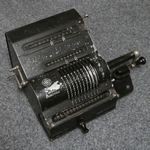
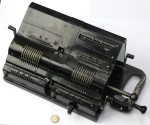
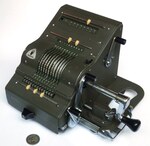
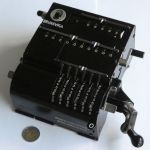
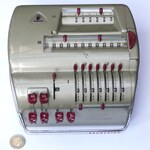
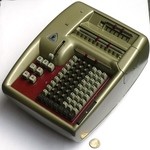
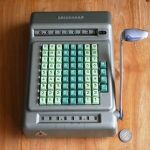
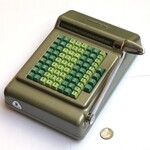
The pinwheel calculator as we know it was invented by Willgodt Theophil Odhner in around 1871. He was Swedish, but was working in Russia at the time for Ludvig Nobel, an oil magnate. Pinwheels had been used before in various forms, but never in large numbers because the precise engineering needed for manufacturing it is difficult. At almost the same time as Odhner in Russia, Frank Baldwin in the USA developed his own pinwheel calculator, but had difficulty selling it. Odhner made a few machines for Nobel, but it wasn't until 1890 that he had an improved design that was easier to make, and had set up a workshop in St. Petersburg to start producing them. The next year he also opened a production plant in Germany, but soon found it too difficult to oversee two such widely separated locations, and in 1892 the German plant was sold to Grimme, Natalis & Co, together with all its equipment, designs and patent licenses to manufacture the Odhner calculator for the German, Belgian and Swiss market.
The company Grimme, Natalis & Co was set up in November 1871 by Carl Grimme and Kaufmann A. Natalis. They were both sewing machine manufacturers who had decided to join forces. They also made other metal household apparatus, like ovens and heaters. In 1892 they began making pinwheel calculators in their plant in Braunschweig (Brunswick) using the brand name Brunsviga, which is the latin name for the town. Their first models, models A and B, were exact copies of the Odhner design, but with different numbers of digits. Soon their main engineer and co-director Franz Trinks devised several improvements (such as safety interlocks) and new designs. It took many years for the market for calculators to develop, but through extensive advertising using the slogan "Gehirn von Stahl" (Brains of Steel), demand grew. Eventually the demand for calculators even began to outgrow that of sewing machines.
While Brunsviga was the first Odhner clone, others would follow, especially after Odhner's patents expired. For example Triumphator, Thales, Walther, Facit, Felix, Tiger, and many others. Willgodt Odhner died in 1905, and his sons took over the company. In the Russian revolution the Odhner company was confiscated, so the Odhner brothers returned to Sweden and started anew with the Original-Odhner company. In Russia the confiscated assets were used to produce the Felix brand of pinwheel calculators.
Meanwhile in Germany, Grimme Natalis & Co released a new series of models in 1925, the "Nova" series, which shared many interchangable parts for ease of production and repair. In 1927 the company incorporated the brand name into its company name, changing it to "Brunsviga-Maschinenwerke Grimme, Natalis & Co ", because by then it was producing calculators almost exclusively.
Competition between calculator companies was fierce, and in 1957 Brunsviga was bought by Olympia, a company that spun off from AEG and which made mostly typewriters but had also started making adding-listing machines. So from then on Brunsviga was once again merely a brand name. By 1959 the merger was complete, and all but a few Brunsviga models were discontinued. By 1964 the only mechanical calculator model they still produced was the Olympia-Brunsviga 13 RM, and in 1970 the last plant that still produced this machine, located in Spain, stopped too.
The "Nova" series of models is the culmination of almost all of Franz Trink's developments. The Nova II was the most popular, and a little over 10,000 Nova II machines were produced from 1925 till 1934. The Nova I had fewer digits, and the Nova III had an extra revolution counter without a carry mechanism. Franz Trinks retired soon after this, and the Brunsviga pinwheel machines remained essentially unchanged until the 1950s. It has many clever features:
One of the few innovations not used in the Nova are longer stationary input pins. Some earlier models had input pins that did not rotate with the pinwheels when the crank was turned, which allowed them to be longer and more comfortable to use. This mechanism must have been considered too expensive or complicated to continue with.
My machine has serial number 6T 2O 864. Note that is the letter O. The first thousand had the numbers 6T 2N xxx, the next thousand 6T 2O xxx, then 6T 2P xxx, after which they switched to a fully numerical format of 103,000 onwards.
The paint on the top cover is crackled, and flaking off quite badly. Mechanically it is in reasonable condition. It mostly works fine, if a little stiffly, except that clearing the input sometimes leaves one of the digits set to 1. The back transfer also sometimes doesn't quite fully push the input pins to the correct position.
Below is a video I made that demonstrates the Brunsviga Nova II.
The model D 13Z/1 consists of two calculators attached side by side, sharing the same drive shaft. The D in the model name stands for Doppel, i.e. double. The individual calculators are model 13Z, so have 13 digits in the register and tens carry (Zehner-Übertrag) in the counter register. The final /1 means that only one of the machines has a counter mechanism.
Such double calculators were used for calculations involving coordinates, often by the military, but also by land surveyors, for example. One calculator would hold the x-coordinate, the other the y-coordinate. There is a switch between the two calculators with which you can set them to move in the same direction (both adding or both subtracting) or the opposite direction (one adding the other subtracting), or disconnect them (so only the right machine turns).
The carriages of the two machines are connected, but still have separate clearing levers. It is possible to manually set the value of these registers by turning the rubber wheels at the front. The lever on the front-left of each carriage disconnects the register from the rest of the mechanism to make the number wheels easier to set.
The lever on the left of the machine clears both input registers. The lever on the right clears the counter, or clears both the counter and the input registers, depending on whether the switch on the right is set to 1 or 2.
The serial number is 208,664, which probably dates it to near the end of the second world war, about 1945. This model was in production from 1934 until 1947.
Geodätisches Rechnen Anleitung für die Brunsviga-Rechenmaschine Doppel 13Z
(PDF, 47.1 MB or archive.org)
K. Schieferdecker
Brunsviga Maschinenwerke AG., Braunschweig
1950
48 page book
212mm × 294mm × 5mm
This book serves as the manual for the Brunsviga D 13Z, and it explains in detail all kinds of coordinate calculations that can be done. The main text is 38 pages, and it then has 10 foldout pages with templates for noting down results of the example calculations in the main text.
Below is a video I made that demonstrates the Brunsviga D 13Z/1.
The model 13RK is the most common post-war Brunsviga pinwheel calculator model. It is obviously a direct descendant of the Nova II above as it has a almost the same size and shape, and very similar functionality. It also has a 13-digit register, 10-digit input, and an 8-digit counter in the body of the machine which automatically switches to negative numbers. Some of the differences are:
The serial number is 266,988, which dates it 1952. This model was in production from 1949 until about 1959. Later versions of this model generally had a metallic silver colour with dark red handles and decimal indicators.
Unlike all other calculators that Brunsviga developed, the Brunsviga 10 has a stepped drum mechanism. It is relatively light and compact, and was apparently cheaper to manufacture. It has a smaller capacity, so it was clearly aimed at the low end of the market. It was made from 1932 until about 1952, with a break during the Second World War. The serial number on my machine is 160,469, which dates it to around 1938.
The case is painted black, like all Brunsviga's of the time. It has a stand that folds out and lifts up the rear of the machine, tilting it towards the user. The stand is released and locked in place by a small metal catch on either side near the bottom.
There is a crank on the right hand side, angled forwards towards the operator and slightly upwards to compensate for the tilt when the stand is used. The crank can be turned clockwise for addition, and anti-clockwise for subtraction.
The 10-digit register sits in a carriage that is in the middle of the machine. On the right there is a clearing handle. Shifting the carriage to the right is done simply by pulling it rightwards using the fixed knob on top. It is springloaded, and pressing the metal lever near the crank shifts the carriage leftwards by one digit. There is an identical left-shift lever on the left side of the machine as well. There is a stationary metal plate covering the left end of the carriage which keeps the mechanism enclosed even when the carriage is at its furthest point. When the register overflows or underflows, a bell is struck.
At the back is a 5-digit counter. It has the same kind of mechanism as the Nova series. On the left is a clearing handle. When it is clear, a green indicator is visible to the left of the counter. In this state the direction of the next turn of the crank determines whether the counter keeps track of additions or of subtractions. If the crank is turned anti-clockwise for subtraction, the windows of the counter shift to the left, revealing a set of red complementary digits, and the counter is adjusted to show the that one subtraction has been performed. Below the counter is an indicator showing the currently active digit corresponding to the location of the carriage.
At the front of the machine is the input register. It has 6 movable pins, each in a slot with the digits 0 to 9 next to them. There is a row of windows which display the current input number directly, making it easier to check it is correct. Unlike most pinwheel machines, the input pins remain stationary when the crank is turned. At the front right is a button which clears the input.
The Brunsviga 10 uses a stepped drum mechanism. Like the drums of the Monroe calculator they are split into two parts, but unlike the Monroe they are actually arranged on two axles. One axle contains drums that can move the number wheels anything from 0 to 4 steps, depending on how much they have been shifted. The other axle contains the carry mechanism and another set of drums that turn the number wheels either 0 or 5 steps. The two axles move in concert and the drums for each wheel are arranged so that they act one after the other.
The input pins are part of large input wheels, and these wheels have a cam profile on either side. These profiles push aside levers by an exact amount depending on the input setting, and those levers are connected through shafts to similar levers that push aside the stepped drums the correct amount.
It was developed by Richard Haase who was working for Grimme Natalis, and patented by him in 1932. There have been some small changes in the design of the Brunsviga 10 during its production run. Until about 1935 they did not have the cover over the left part of the register, so the mechanism was exposed when the carriage was shifted. Almost 10,000 were made before the last years of the war interrupted production. When production restarted a few years after the war, they were slightly updated by being painted green instead of black, and they had no input clearing button, and no extra carriage shift lever on the left side.
The serial numbers used on the Brunsviga 10 were not a single consecutive set. The numbering was shared between all models, and in 1932 when this model started production they were at about 136,000, and in 1943 when production was paused they were at about 192,000. I presume number ranges of size 500 or 1000 were assigned to each model, with a new range assigned whenever the previous was used up. This means that the serial numbers give a good estimate of the total number of machines that Brunsviga produced, but they say little about any particular model. There may also be large gaps in the serial numbers which were used by other more popular models. When production restarted a few years after WW2 the serial numbers were about 230,000, and when it ended in 1952 the numbers were about 248,000.
In 1952 it was redesigned and this version was first named the B10 and then renamed the Nova 10. It had a more rounded green case, and internally the mechanism was changed to put all the stepped drums on a single axle. At the same time an electrically driven version was made which had one digit more capacity on all the registers, and it was called the model 11E. A few years later the model 11S was made too, which was a version of the electric model 11E with a full-sized keyboard.
Here is a video where I demonstrate the Brunsviga 10.
Here is a video showing the mechanism of the Brunsviga 10.
The Brunsviga 11E is a further development of the Brunsviga 10. It was made from about 1952 until at least 1959. The serial number on my machine is 11-16,672, which dates it to 1957.
The case is painted a metallic silvery gold and it has red keys. It has an 11-digit register to match its increased model number. The counter has 6 digits, and there are 7 digits of input set using a set of input pins. It is electrically driven, using the motor to perform the addition or subtraction, as well as to clear the register or counter. Shifting the carriage to the right is still manual however, though it moves left by a spring. There is a latch on the right hand side of the carriage that locks the carriage in place for transport.
The counter has the same mechanism as the Nova series for counting positive numbers in white, negative numbers in red, with the choice depending on the first operation after clearing the counter. There is a red underline marker under the current digit of the counter, where the current digit depends on the location of the carriage.
At the front-right of the machine is the input register. It has 7 movable pins, each in a slot with the digits 0 to 9 next to them. There is a row of windows which display the current input number directly, making it easier to check it is correct. Unlike most pinwheel machines, the input pins remain stationary when the crank is turned. At the front left are the various control buttons. The buttons marked I, II, and III will clear the input, counter, and register respectively. The left-arrow button shifts the carriage to the left, and the + and - buttons perform an addition or subtraction.
The selection switch next to the buttons has three options:
The Brunsviga 11E has a similar stepped drum mechanism as the Brunsviga 10, so see above for a more in depth description. It has a small electric motor at the back that is connected to the mechanism through a drive belt. There is no reversing gear, but for subtraction the polarity is switched so that the motor drives in reverse.
Here is a video where I demonstrate the Brunsviga 11E.
The Brunsviga 11S is somewhat similar to the 11E except it has a keyboard for inputting numbers. It was made from about 1957, but seems not to have been in production for very long, almost certainly no longer than until 1959. The serial number on my machine is 10-01290, which dates it to 1957.
The case of this machine is the same metallic silvery gold as the 11E, but with grey buttons on its keyboard which contrast against a dark red keyboard plate. It has an 11-digit register, a 6-digit counter, and there are 7 columns on its keyboard. It is electrically driven, using the motor to perform the calculations, as well as to clear the register or counter, and to shift the carriage to the right. Shifting the carriage to the left is done by a spring, and clearing the keyboard also does not need the motor.
To the left of the keyboard are the controls. The buttons marked I, II, and III will clear the input, counter, and register respectively. The arrow buttons shift the carriage, and the + and - buttons perform an addition or subtraction. There is a second + button to the right of the keyboard which is easier to reach.
The selection switch above the control buttons has three options:
The Brunsviga 11S, like the 11E, has a similar stepped drum mechanism to the Brunsviga 10, so see above for a more in depth description. It has a small electric motor at the back that is connected to the mechanism through a drive belt. There is no reversing gear, but for subtraction the motor is driven in reverse.
Here is a video where I demonstrate the Brunsviga 11S.
In this video I show the machine running with the case removed.
The Brunsviga 90 TA is full keyboard adding machine. The keyboard has 8 columns
of keys, where each column has nine keys numbered from 1 to 9. Below the
keyboard is an 8-digit input register which shows the number entered on
the keys. There is a more common, cheaper version called the 90 T which does
not have the input display register. Above the keyboard is a 9-digit results
register. The register has a sliding window to allow negative numbers to be
displayed through the use of complementary digits.
Attached to the right side of the machine is a large lever which is pushed down
and released to perform any one of the three operations adding, subtracting or
clearing the register. There are four control keys at the right of the keyboard.
The usage of these keys is explained below.
It has serial number 22-05788, dating it to 1957.
The mechanism uses toothed racks. Pushing the lever downwards lifts the register up away from a set of toothed racks, and these racks are pulled forward. They move until they hit a blockage determined by the input key settings. When the lever is released, the register descends onto the racks, and the racks are returned to their original position, turning the register's number wheels in the process. Switching between addition and subtraction is done by shifting the whole register sideways, which connects the number wheels to the racks without the use of an intermediate wheel, making them turn in the opposite direction.
The Brunsviga Adsum 94 T is a version of the Brunsviga 90 T which is specially adapted for calculations involving British currency. The keyboard still has 8 columns of keys. The right-most column is for pence, of which there are 12 to a shilling, so the column has eleven keys numbered from 1 to 11. The next two columns are for shillings. There are 20 shillings to a pound, so the right column of the pair is a normal decimal column with nine keys numbered 1 to 9 and the left column has nine keys all with the number 1. The remaining five columns are normal columns with keys 1 to 9.
Above the keyboard is a results register with 9 number wheels. The last
wheel counts up to 11. The register has a sliding window to allow negative
numbers to be displayed through the use of complementary numbers.
The other controls are identical to those of the Brunsviga 90 TA,
so there are four buttons on the right of the keyboard and a large lever for
performing an operation. The usage of these keys is explained below.
This machine has serial number 22-05389, dating it to 1957.
The mechanism is almost identical to that of the Brunsviga 90 T. The third number wheel shows the numbers 0 and 1 five times, so as it goes through a full rotation it will carry to the fourth wheel five times instead of just once.
| Entering a number: | Enter the number on the keyboard, pressing one key in each column that has a non-zero digit. For example, to enter 104, press the 4 key in the rightmost column and the 1 key in the third column from the right. You can clear the entered number by pressing C. |
|---|---|
| Addition: | Enter the number to add on the keyboard. Press down and release the lever. |
| Subtraction: | Enter the number to subtract on the keyboard, and also press the minus button. Press down and release the lever. |
| Negative Results: | If the register underflows because the result is a negative number, then shift the register's sliding window to the left. The register now displays the complementary digits with a green background. If the last number wheel is not a zero, then the displayed number is the correct negative result. If the last number wheel shows zero, which is shown with a red dot in its centre, that zero should really be thought of as a ten (or as 12 pence on the Adsum 94T). To get the actual negative number, that ten should be mentally carried over to the tens digit. For example, if the register displays in green the number 699 then it means -699, but if it displays a green number 690, then it really means the number -700. |
| Clear register: |
Press the * button, then press down and release the lever.
IMPORTANT NOTE: If the last operation was a subtraction, then the * button cannot be pressed down. If this happens, then push and release the lever (effectively adding a zero). You can then clear the register normally. |
| Repeated addition: |
Enter the number and press the R button. Repeatedly push the lever as many times as
you want to add the number. Press the C key to clear the input.
Repeated subtraction is possible, but you have to press the minus and the R buttons simultaneously to get them to stay pushed in. |
This machine was not actually developed by Brunsviga but originally produced by Komet. The company Komet Rechenmaschinen GmbH was founded on June 1951 by Hugo Schumann in Frankfurt, and produced four calculator models. These machines were probably all manufactured in the machine workshop run by Siegfried Link in Griesheim, near Darmstadt. The first model in production was the Komet SK. It was a licensed copy of the Resulta BS7 (except that it had 8 digits) and was their cheapest and most successful model. Similarly, the Komet R8 was a copy of the Resulta AS7. The third model was the Komet TA 8/9, designed by Siegried Link. It came to market in 1953. The last model was the Komet DM 10, which was a large calculator with a full keyboard and a carriage, somewhat similar to a Monroe.
The Komet company went bankrupt in November 1955, less than four and a half years after it was founded. It is probable that the development and production of model DM 10 was too expensive and ambitious for this small young company. About 16,000 model SK were sold, about 1,000 of the model TA 8/9, but it is unclear whether the model DM 10 even reached the market as hardly any machines of this model exist. Brunsviga bought all rights to the model TA 8/9, and all remaining stock was rebadged and sold as the Brunsviga Jedermann. They continued production of the model which was dubbed the Brunsviga 90 TA, and also the variant without the input register display called the Brunsviga 90 T.
The Brunsviga 90 TA and its variants were at first still manufactured in Siegfried Link's factory where its predecessor, the Komet TA 8/9 was made. Brunsviga did however set up production in their own factories, and by the end of May 1957 the transfer was complete so that Link's production line ended. These machines were made until about 1958 or 1959, when production of this and many other Brunsviga models was halted. Note that Siegfried Link survived this setback, restarting production of the Komet SK, now renamed the Link SK. His new company also managed to diversify into making parts for other industries, for example for cars and bicycles.
Here is a table of the variants of this machine that I am aware of. I have not found any Adsum variant with an input display.
| Model | Description |
|---|---|
| Komet TA 8/9 | Decimal; With or without input display |
| Brunsviga 90 TA | Decimal; With input display |
| Brunsviga 90 T | Decimal; Without input display |
| Brunsviga Adsum 94 T | British currency (£sd); Without input display |
| Brunsviga Adsum 948 T | British currency (£sdf); Without input display |
Below is a video I made that demonstrates the Brunsviga 90 TA.
I found some tables of serial numbers in scans on Rechner Lexicon, and I'll reproduce that data here. It goes from 1940 to 1957. Up to 1953 the numbering was consecutive and shared by all the calculator models. There was a separate series of serial numbers for all the adding machine models.
|
| ||||||||||||||||||||||||||||||||||||
From 1954, each model has its own numbering consisting of a model prefix that is unique to that model (or set of closely related models) followed by a serial number.
| Pinwheel models | |||||
|---|---|---|---|---|---|
| Prefix | 12- | 13- | 14- | 15- | 16- |
| Year | Mod B20 | Mod 13RK/18RK | Mod D13 | Mod 16T | Mod 16E |
| 1954 | 27,001-27,590 | 30,030-36,215 | 05,000-05,037 | 01,001-01,059 | |
| 1955 | 27,591-28,995 | 36,216-47,014 | 05,036-05,218 | 01,001-01,358 | 01,060-01,176 |
| 1956 | 28,996-30,149 | 47,015-55,875 | 05,219-05,440 | 01,359-03,959 | 02,001-02,070 |
| 1957 | 30,150-30,927 | 55,876-63,710 | 05,441-05,654 | 03,960-05,091 | 02,071-02,970 |
| Stepped drum models | ||
|---|---|---|
| Prefix | 10- | 11- |
| Year | Mod 11S | Mod 11E |
| 1954 | 06,000-07,514 | |
| 1955 | 07,515-09,971 | |
| 1956 | 09,972-14,560 | |
| 1957 | 01,200-01,428 | 14,561-17,660 |
| Adding machines | |||
|---|---|---|---|
| Prefix | 21- | 31- | 32- |
| Year | Mod 1000 | Mod 89 | Mod 111, 1010 |
| 1954 | 14001-14063 | 22001-28800 | 09001-10244 |
| 1955 | 14064-14251 | 28801-38551 | 10245-12243 |
| 1956 | 14252-14320 | 38552-47520 | 12244-15018 |
| 1957 | 14321-14421 | 47521-52400 | 15019-18000 |
| Models 90T/TA, Adsum 94T, etc. | |
|---|---|
| Prefix | 22- |
| Year | |
| 1955 | 01,001-01,009 |
| 1956 | 01,010-03,489 |
| 1957 | 03,490-06,240 |
| Note that Siegfried Link produced them too, with 5-digit serial numbers until July 1956, and then numbers 23-02,001 to 23-03,805 until May 1957. | |
Instructions for using the "Brunsviga" calculating machine (PDF, 9.25 MB or archive.org)
Grimme, Natalis & Co., Brunswick, Germany
1905
12-page stapled booklet
139mm × 213mm × 1mm
This is a manual for the earliest Brunsviga machines. The cover shows the model A, and the picture on the first page shows the model B with a wide body which was only produced in 1905 and 1906. The manual has only very brief explanations of the four arithmetic operations.
General Instruction Book for the Brunsviga Universal Calculating Machine (PDF, 56.7 MB or archive.org)
Brunsviga Calculator Co., 4 St. Paul's Churchyard, London E.C.4.
1922
41-page booklet
146mm × 224mm × 2mm
This is the basic manual for the early Brunsviga machines, in particular the models B, MH, MJR, and MDIIR. It explains the four arithmetic operations of course, but also covers various special methods and short cuts, as well as British currency. The booklet has no copyright date, but the code on the front suggests it was printed in 1922.
Brunsviga 13 R (PDF, 13.9 MB or archive.org)
Die leichtverständliche Schule für den Umgang und das Rechnen mit der BRUNSVIGA 13 R
Brunsviga Maschinenwerke AG., Braunschweig
1950
37-page booklet
211mm × 146mm × 3mm
This is the basic manual for the Brunsviga 13 R in German. It explains the four arithmetic operations of course, but also covers various applications and methods including percentage calculations and interest. There is even a section on taking square roots. There are various tables for interest calculations and for imperial weights. At the back an extra page has been pasted in which explains that the Brunsviga 13 RK has an extra switch with which you can select which registers to clear. The booklet has a copyright date of 1950.
The manual also came with a loose page in 6 languages that explains how to release the carriage after it has been locked for safety during transport.
Brunsviga 13 R (PDF, 17.5 MB or archive.org)
Brunsviga Maschinenwerke AG., Braunschweig
1950
39-page booklet
211mm × 146mm × 3mm
This is the basic manual for the Brunsviga 13 R in French. It is virtually identical to the German version above.
Brunsviga 13 RK
Brunsviga Maschinenwerke AG., Braunschweig
1954
36-page booklet
211mm × 146mm × 3mm
This is the basic manual for the Brunsviga 13 RK in German. The text is identical to that of the manual above for the model 13 R except that the added page for model 13 RK has been incorporated into the main text, and the large fold-out diagram now depicts the new model. The booklet has a copyright date of 1954.
Gebrauchsanweisung B11E (PDF, 19.2 MB or archive.org)
Brunsviga Maschinenwerke AG., Braunschweig
1952
36-page booklet
211mm × 146mm × 2mm
This is the manual for the Brunsviga 11E in German. It explains
the four arithmetic operations and even square roots, and has some real
world calculation examples and useful tables.
The booklet has a copyright date of 1952, and was printed in July
of that year.
Gebrauchsanweisung und Rechenanleitung Addier- und Saldiermaschinen mit Zehnertastatur
(PDF, 10.9 MB or archive.org)
Brunsviga Maschinenwerke AG., Braunschweig
1956
30-page booklet
208mm × 146mm × 2mm
This is the German manual for the 10-key adding listing machines made by
Brunsviga. It explains how to replace the paper and ink ribbon, addition
and subtraction, and then briefly multiplication.
The booklet does not have a copyright date, but the printing code on
the back indicates it was printed in January 1956.
Calendar Coin
1908
This is a coin or medal made of a light metal, possibly a zinc alloy. One side
bears the image of a Brunsviga pinwheel calculator, with the text
"Grimme Natalis & Co., Brunsviga, Braunschweig".
The other
side has a perpetual calendar for the years 1908 to 1928. A thin plate
covers most of this side of the coin except for two windows. When you rotate
the coin so that the year in the top window lines up with the month on
the front plate, the other window shows the correct days of the week for the
calendar for that month and year.
It has some instructions in German: "Man setze
gewuenschten Monat unter Jahr. Unterstrichene Jan & Feb dienen nur fuer
Schaltjahre."
Die Braunschweiger GNC Monatsschrift
Grimme, Natalis & Co.
December 1913
103 page booklet
170mm × 232mm × 5mm
This was a monthly publication by Grimme Natalis, which mostly had articles
on subjects related to the history and culture of the Brunswick region.
This issue is about the town of Wolfenbüttel, its history, music, its
famous library, and its poets. At the back are several pages of advertisements,
mostly from companies from Wolfenbüttel, as well as for the Brunsviga of
course.
Geschichtliche Daten aus der Entwicklung der Rechenmaschine von Pascal bis zur Nova-Brunsviga (PDF, 26.3 MB or archive.org)
Dr. Ing. eh. Franz Trinks
1926
40-page booklet
170mm × 230mm × 2mm
This German booklet gives a short history of the development of mechanical calculators, ending with a description of the full range of Brunsviga-Nova calculators that were available. It was written by Franz Trinks, who was the main engineer who designed the Nova series. A year after its publication in 1926 it was reproduced in the Grimme-Natalis company magazine, Braunschweiger GNC-Monatsschrift #14.
Différents Modèles Nova-Brunsviga
1925
4-page leaflet
212mm × 281mm
This French leaflet has pictures of the models Nova I, Nova IVa, Nova 13, and Nova Duplex, and also briefly describes the Nova II and Nova IV.
Nova II-IV9
December 1929
Trifold leaflet
148mm × 210mm
This French leaflet shows and describes the models Nova II and Nova IVa. The models Nova III and Nova IV are briefly mentioned.
Nova 13-13Z
March 1930
Trifold leaflet
148mm × 210mm
This French leaflet shows and describes the models Nova 13, Nova 13Z, Nova 13ZG, and Nova 13ZK, where the latter two are on an additional page pasted in the middle. Also listed are the Nova II, Nova III, Nova IV, Nova IVa, and Dupla.
Tabelle der reziproken Werte von 1-1000 für BRUNSVIGA-Rechenmaschinen und BRUNSVIGA-Addiermaschinen
May 1956
Trifold leaflet
98mm × 210mm
This is a table of reciprocals from 1/1 to 1/1000. The front has pictures of the models 11 E, G 111 E, and 13 RK.
Here are a various advertisements relating to Grimme Natalis & Co, their Brunsviga calculators, and to Olympia.
Here are some articles related to Grimme, Natalis & Co., and Brunsviga calculators.
Die Rechenmaschine Brunsviga
(1897-08-18, Prometheus)
Modern Instruments and Methods of Calculation, a Handbook of the Napier Tricentenary Exhibition
(1914)
Illustriertes Orga-Handbuch erprobter Büromaschinen
(1921, Ludwig Brauner and Victor Vogt)
The Calculating Machines
(1925, Ernst Martin)
Organisations-Lexikon
(1930, Walter Le Coutre and Walter Thoms)
Moderne Buero-Maschinen
(1931)
Elementary Mathematics from an Advanced Standpoint
(1932, Felix Klein)
Here is a large selection of patents relating to Brunsviga's pinwheel machines leading up to the Nova series. Most are by Franz Trinks.
| Patent | Filing date | Published date | Name | Description |
|---|---|---|---|---|
| DE 124,578 | 07-07-1900 | 21-10-1901 | Franz Trinks | Lock crank/input when clearing See also AT 9,031 B, GB 1900/19,762 |
| DE 126,743 | 26-06-1900 | 08-01-1902 | Franz Trinks | Lock input when crank turns See also AT 9,034 B, GB 1900/19,762 |
| FR 344,541 | 07-09-1904 | 07-11-1904 | Franz Trinks | Input register |
| AT 30,756 B | 16-11-1905 | 25-11-1907 | Franz Trinks | Lock input when shifting carriage |
| AT 30,763 B | 16-11-1905 | 25-11-1907 | Franz Trinks | Overshoot prevention |
| DE 185,005 | 07-11-1905 | 16-05-1907 | Franz Trinks | Lock input through pin at crank handle |
| AT 32,602 B | 19-10-1906 | 10-04-1908 | Franz Trinks | Independent input pins See also FR 6,833 E, GB 1906/23,659 |
| FR 362,969 | 21-04-1906 | 18-07-1906 | Franz Trinks | Carry mechanism lever |
| US 843,506 | 06-03-1906 | 05-02-1907 | Franz Trinks | Input lever arrangement |
| DE 203,659 | 26-10-1907 | 29-10-1908 | Franz Trinks | Counter with complemetary digits See also AT 39,207 B, CH 45,340, DK 12,416 C, FR 395,531, GB 1908/22,435, US 935,565 |
| US 975,180 | 13-06-1907 | 08-11-1910 | Franz Trinks | Fixed counter |
| AT 43,003 B | 29-03-1909 | 11-07-1910 | Grimme, Natalis & Co. | Carriage shift by button press See also CH 50,241, FR 409,262, US 967,821 |
| AT 43,677 B | 29-03-1909 | 25-08-1910 | Franz Trinks | Back transfer |
| DE 224,131 | 25-07-1908 | 12-07-1910 | Grimme, Natalis & Co. | Register locking mechanism See also AT 47,275 B, CH 49,626, DK 13,282 C, US 953,622 |
| DK 13,284 C | 10-07-1909 | 30-05-1910 | Grimme, Natalis & Co. | Carriage shift mechanism See also CH 49,628, FR13873E, FR 406,992, US 946,367 |
| AT 59,385 B | 24-04-1912 | 26-05-1913 | Franz Trinks | Block input when clearing register See also CH 59,698, FR 443,343, GB 1912/10,604, US 1,040,059 |
| AT 61,307 B | 12-10-1912 | 25-09-1913 | Franz Trinks | Input display register See also CH 61,229, FR 449,723, GB 1912/24,275 |
| AT 63,783 B | 02-01-1913 | 10-03-1914 | Franz Trinks | Ratcheted clearance mechanism See also CH 62,620, FR 452,838 |
| AT 66,728 B | 18-10-1913 | 25-09-1914 | Franz Trinks | Carry mechanism See also CH 66,344, FR 463,789, GB 1913/25,754 |
| AT 66,729 B | 22-12-1913 | 25-09-1914 | Franz Trinks | Carry mechanism See also CH 67,131, FR 466,956, GB 1914/00,037, US 1,098,193, US 1,100,631 |
| AT 68,733 B | 16-03-1914 | 25-05-1915 | Franz Trinks | Carry mechanism improvement See also CH 68,850, FR 470,156, GB 1914/07,963, US 1,134,780 |
| AT 68,992 B | 27-03-1914 | 10-06-1915 | Franz Trinks | Optionally copied input See also CH 71,871, GB 1914/08,867, US 1,118,829 |
| FR 467,396 | 17-01-1914 | 10-06-1914 | Carl Rasmussen; Grimme, Natalis & Co. | Carry mechanism |
| AT 72,870 B | 06-08-1915 | 27-12-1916 | Franz Trinks | Lock crank when pins not aligned See also CH 71,476, FR 520,006, GB 147,114, US 1,220,029 |
| CH 72,515 | 29-11-1915 | 02-06-1916 | Grimme, Natalis & Co. | Lock crank when pins not aligned See also US 1,194,900 |
| CH 72,990 | 27-11-1915 | 01-08-1916 | Grimme, Natalis & Co. | Pin alignment |
| CH 72,991 | 27-11-1915 | 17-07-1916 | Franz Trinks | Lock crank when pins not aligned? |
| CH 91,917 | 16-06-1920 | 01-12-1921 | Franz Trinks | Mechanism for shifting window on counter |
| DE 321,611 C | 23-04-1919 | 09-06-1920 | Franz Trinks | Counter register with complementary digits and sliding window See also SU 10,427 |
| DE 325,901 C | 18-04-1919 | 09-01-1922 | Franz Trinks | Counter register with complementary digits and sliding window See also AT 86,598 B, CH 90,733, DE 325,902 C, DE 325,903 C, SU 10,427,US 1,445,461 |
| AT 90,434 B | 10-12-1920 | 27-12-1922 | Franz Trinks | Fixed counter above input See also CH 91,167, FR 528,855, GB 157,898 |
| DE 354,897 C | 21-06-1921 | 20-06-1922 | Grimme, Natalis & Co. | Mechanism for shifting window on counter |
| DE 359,634 C | 18-12-1921 | 25-09-1922 | Grimme, Natalis & Co. | Input alignment mechanism |
| DE 377,424 C | 15-09-1922 | 18-06-1923 | Grimme, Natalis & Co. | Lock for transport |
| DE 378,838 C | 01-11-1922 | 06-08-1923 | Grimme, Natalis & Co. | ?? shifting mechanism |
| DE 383,722 C | 31-10-1922 | 17-10-1923 | Grimme, Natalis & Co. | ?? Register clearing mechanism disengages clicking mechanism |
| DE 384,531 C | 22-08-1922 | 03-11-1923 | Grimme, Natalis & Co. | Input clearing mechanism |
| DE 386,578 C | 21-11-1922 | 21-12-1923 | Grimme, Natalis & Co. | Number wheel |
| DE 390,460 C | 29-03-1923 | 19-02-1924 | Franz Trinks | Warning bell on counter with sliding window See also AT 99,483 B, CH 108,102, DK 34,004 C, FR 577,413, GB 213,549 |
| DE 393,955 C | 20-06-1923 | 11-04-1924 | Franz Trinks | Carriage shifting mechanism |
| DE 396,316 C | 21-03-1922 | 02-07-1924 | Grimme, Natalis & Co. | Input clearing disengages clicking mechanism |
| CH 107,414 | 09-02-1924 | 16-10-1924 | Grimme, Natalis & Co. | Pinwheel See also DK 33,854 C, FR 577,245, GB 212,540 |
| AT 99,766 B | 07-02-1924 | 25-04-1925 | Franz Trinks | Warning bell on counter with sliding window See also CH 108,220, DK 34,136 C, FR28776E, GB 212,561 |
| AT 101,809 B | 20-09-1924 | 25-11-1925 | Grimme, Natalis & Co. | Crank handle cradle lock See also CH 110,312, DK 35,306 C, FR 586,482, GB 224,212 |
| CH 110,311 | 03-09-1924 | 01-06-1925 | Grimme, Natalis & Co. | Carriage shift mechanism See also DK 34,566 C, GB 223,895, SU 5,719 |
| GB 212,548 | 03-03-1924 | 22-01-1925 | Grimme, Natalis & Co. | Shifting carriage rack |
| GB 223,894 | 08-10-1924 | 11-06-1925 | Grimme, Natalis & Co. | Number wheel |
| GB 224,211 | 04-10-1924 | 12-03-1925 | Grimme, Natalis & Co. | Single tooth drive |
| CH 113,198 | 23-03-1925 | 02-01-1926 | Grimme, Natalis & Co. | Clearing indicator See also GB 233,672 |
| DE 401,412 C | 02-03-1924 | 04-09-1924 | Grimme, Natalis & Co. | decimal point indicators |
| DE 404,370 C | 17-04-1924 | 18-10-1924 | Grimme, Natalis & Co. | carry mechanism See also DE 412,945 C, FR 595,063, GB 232,577 |
| DE 404,887 C | 14-05-1924 | 25-10-1924 | Grimme, Natalis & Co. | Clearing mechanism See also CH 112,987, DK 35,289 C, GB 234,061 |
| DE 405,482 C | 17-04-1924 | 06-11-1924 | Grimme, Natalis & Co. | carry mechanism See also GB 232,567 |
| DE 408,461 C | 11-04-1924 | 29-01-1925 | Grimme, Natalis & Co. | Guard against crank reversal |
| DE 409,297 C | 22-06-1924 | 05-02-1925 | Grimme, Natalis & Co. | Lock input |
| DE 411,403 C | 12-10-1924 | 20-03-1925 | Grimme, Natalis & Co. | Decimal point indicator |
| DE 412,373 C | 02-10-1924 | 21-04-1925 | Grimme, Natalis & Co. | Lock input |
| DE 415,284 C | 18-04-1924 | 12-02-1928 | Grimme, Natalis & Co. | pins in two sections |
| DE 416,830 C | 24-12-1924 | 27-07-1925 | Grimme, Natalis & Co. | Carry mechanism |
| DE 419,313 C | 20-12-1924 | 08-10-1925 | Grimme, Natalis & Co. | Simplified number wheel construction See also AT 102,415 B, CH 113,197, DK 35,372 C, GB 229,301 |
| DE 426,140 C | 20-12-1924 | 09-03-1926 | Grimme, Natalis & Co. | Improved pinwheel See also AT 102,414 B, CH 112,632, DK 35,119 C, FR 596,069, GB 228,902 |
| DE 414,135 C | 21-09-1923 | 17-02-1926 | Grimme, Natalis & Co. | Calculation mechanism timing See also CH 118,488, DK 35,686 C, SU 7,077 |
| DE 416,040 C | 15-01-1925 | 07-07-1925 | Grimme, Natalis & Co. | Carriage alignment during back transfer See also GB 230,828 |
| DE 416,828 C | 04-02-1925 | 27-07-1925 | Grimme, Natalis & Co. | Turn direction indicator |
| DE 417,288 C | 05-02-1925 | 10-08-1925 | Grimme, Natalis & Co. | Backtransfer interlock See also CH 118,033, DK 36,935 C, FR 610,268 |
| DE 417,396 C | 04-02-1925 | 14-08-1925 | Grimme, Natalis & Co. | Backtransfer See also CH 118,489, DK 36,934 C, FR 610,247, SU 7,076 |
| DE 418,746 C | 27-02-1925 | 21-09-1925 | Grimme, Natalis & Co. | Backtransfer interlock See also CH 118,490, DK 36,936 C, FR 610,269, SU 8,380 |
| DE 418,749 C | 20-02-1925 | 21-09-1925 | Grimme, Natalis & Co. | Clearing mechanism for register See also CH 117,597, DK 36,643 C |
| DE 437,284 C | 30-04-1926 | 18-11-1926 | Grimme, Natalis & Co. | Crank cradle pincer |
| Here are the patents related to the Brunsviga 10 and its descendants. | ||||
| Patent | Filing date | Published date | Name | Description |
| DE 554,277 C | 07-03-1931 | 16-06-1932 | Grimme, Natalis & Co. | Brunsviga 10 |
| DE 565,704 C | 04-09-1931 | 24-11-1932 | Grimme, Natalis & Co. | Input mechanism |
| DE 576,881 C | 02-10-1931 | 04-05-1933 | Grimme, Natalis & Co. | Carry mechanism |
| DE 578,683 C | 04-09-1931 | 17-06-1933 | Grimme, Natalis & Co. | Keyboard and back transfer |
| US 2,042,986 | 08-06-1932 | 02-06-1936 | Richard Haase; Grimme, Natalis & Co. | Brunsviga 10, single axle |
| US 2,545,550 | 14-09-1949 | 20-03-1951 | Kurt Jordan; Brunsviga Maschinenwerke | Improved input clearing mechanism |
| US 2,648,498 | 14-09-1949 | 11-04-1953 | Kurt Jordan; Brunsviga Maschinenwerke | Improved drum axle construction |
| Here are the few design patents related to the Brunsviga TA, by Siegfried link. | ||||
| Patent | Filing date | Published date | Name | Description |
| DE 1,709,046 U | 26-07-1955 | 27-09-1955 | Siegfried Link | Green complement numbers |
| DE 1,709,047 U | 30-07-1955 | 27-09-1955 | Siegfried Link | Input register |
© Copyright 2019-2024 Jaap Scherphuis, mechcalc a t jaapsch d o t net.